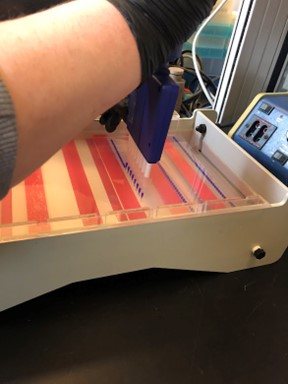The activities are as follows:
- Teacher Guide
- Student activity, Graph Type A, Level 4
- Student activity, Graph Type B, Level 4
- Student activity, Graph Type C, Level 4
- Supplemental Activity, Student Handout
- Grading Rubric
Kernza® is a new grain crop that is similar to wheat. It can be ground into flour and used in bread, cookies, crackers and more! Unlike wheat, the rest of the plant can be eaten by livestock such as cattle. Another difference is that Kernza® is a perennial, meaning it grows in the ground for multiple years, whereas annual wheat only grows for one year. However, the challenge is that annual wheat makes more grain and is easier to harvest and sell. This means farmers currently prefer growing annual wheat over Kernza®.
One way to address this mismatch between annual and perennial crops is through selective breeding. This is when humans select individual plants with traits that are desirable for a specific reason. This group of individuals are strategically bred together. The breeder’s goal is to shift the traits over generations. Scientists have only been working on breeding Kernza® for the past few decades; in comparison, humans started selecting annual wheat traits over 10,000 years ago! That is a lot of time to get the traits we are looking for.
Kernza® breeders are working on improving the same traits that have already been improved in annual wheat, including larger seed size. Kernza® scientists follow two main steps to breed plants 1) they select the best individuals from the population and 2) they intercross those individuals to create the next generation, or breeding cycle. With each breeding cycle, plant breeders see a slight improvement in the traits they selected.
Breeders can select plants based on phenotypes, genotypes, or both. Historically, plant breeders have selected based on desired phenotypes, or visible traits, only. Modern plant breeding can take advantage of the fact that we can now look at genotypes, or the genetic makeup, of individual plants quickly and at low costs. Scientists can use this information to make quicker breeding improvements, so we don’t have to wait another 10,000 years for high-yielding Kernza®!

Hannah is a scientist currently working on Kernza®. Hannah’s passion for plant breeding was ignited during her high school years. She discovered the captivating world of genetics in her AP Biology class. It was then that she first realized the potential for breeding crop plants to make them more productive and viable for human consumption.
Hannah decided to join other scientists who work on Kernza® at the University of Minnesota. Here, scientists have completed four breeding cycles and are about to start the fifth. Hannah wanted to see whether different genetic makeups (genotypes) lead to differences in seed size (phenotypes). Her goal was to look at each plants’ phenotype and genotype for seed size.
To genotype a plant, scientists collect a small piece of leaf tissue, extract the DNA, and send the DNA to a lab for sequencing. This process tells scientists the genetic makeup that ultimately leads to the traits that we see. Specifically, sequencing data identifies nucleotides, or genetic building blocks of each plant’s DNA. Plants have thousands of genes, which are made up of the DNA nucleotides A, T, C, and G.
Sequencing data can be recorded in several ways. One common way is as SNP data, or Single Nucleotide Polymorphism data. You can think of SNP data as the recipe for proteins. In a SNP dataset, each SNP represents a difference in a nucleotide. Similar to using a different ingredient in a recipe, different nucleotides can result in a different phenotype.
By looking at SNP data, plant breeders can identify differences in genotypes that lead to certain phenotypes. Hannah started by evaluating 1,000 Kernza® plants from the first four breeding cycles. Data on phenotypes had already been recorded for these plants. Hannah then collected SNP data to determine their genotypes as well. She was looking for a pattern between genotypes and phenotypes. If she sees that different genotypes have different phenotypes, scientists can then rely on genotypes to select individuals to breed in future breeding cycles.
Featured scientist: Hannah Stoll (she/her) from the University of Minnesota
Flesch–Kincaid Reading Grade Level = 8.9
Additional teacher resources related to this Data Nugget include:
- Hannah, the scientist, made a slideshow to go along with this activity.
- Check out this overview of translation and transcription by Khan Academy.

